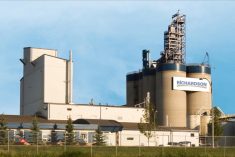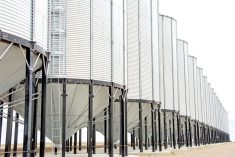While it shouldn’t surprise anyone that the number of larger farms by sales in Canada is rising and the number of smaller farms is declining, Canada’s newest ag census also shows larger farm classes now capturing the majority of total ag revenue.
Statistics Canada on Wednesday began releasing data from its 2021 Census of Agriculture, and the agency’s changes to the definition of a “farm” — and a noteworthy new entrant not included in the listed mix of Canadian cash crops — make some, but not all, direct comparisons to the numbers from 2016 or earlier censuses more difficult.
Read Also

U.S. grains: Soybeans rise on China demand hopes; corn and wheat rebound
Chicago Board of Trade soybean, corn and wheat futures rose on Monday on signs of progress towards the end of a record-long U.S. government shutdown, along with expectations of a revival of U.S. soybean exports to China, analysts said.
StatsCan noted a “significant conceptual change” for 2021 in which a “farm” or an “agricultural holding” now refers to “a unit that produces agricultural products and reports revenues or expenses for tax purposes to the Canada Revenue Agency.” In 2016 and earlier censuses, a “farm” was “an agricultural operation that produced at least one agricultural product intended for sale.”
That change, StatsCan said, “may result in farms being classified differently across farm types than in previous censuses,” so “comparisons with earlier census results should be interpreted with caution.”
The 2021 census counted 189,874 farms in Canada, for a “moderate” decrease of 1.9 per cent from 2016, on total area of 153,687,771 acres, down 3.2 per cent. The decline in the number of farms was the smallest in 25 years, StatsCan said.
Of the 2021 total, 34.3 per cent of farms are in oilseeds and grains, followed by 20.9 per cent in beef cattle and feedlots; those two sectors combined account for 82.7 per cent of total farm area.
Many farms, StatsCan said in Wednesday’s report, have consolidated and become increasingly larger both in terms of sales and number of employees. “Conversely, smaller and mid-sized farms are declining in Canada, thereby impacting the rural landscape and profile of Canadian regions.”
The proportion of farms with sales of $1 million or more in 2020 was 9.9 per cent, up from 7.2 per cent in 2015, StatsCan said.
And in 2021, farms reporting at least $2 million in sales accounted for over half of Canada’s total farm operating revenues, at a share of 51.5 per cent, up from 41.5 per cent in 2016.
Farm operating revenues in Canada totalled $87 billion in 2020 against expenses of $72.2 billion, StatsCan said. On average, for every dollar in revenues, farms incurred 83 cents in expenses. Farms classified as oilseed and grain farming were the most profitable, with an expenses-to-revenues ratio of 0.76; Sheep and goat farms had the highest ratio, at 0.97.
Older on average
The average age of Canada’s farm operators rose to 56 in 2021, from 55 in 2016. The median age of farm operators, meanwhile, is 58, up from 56. In 2021, 60.5 per cent of farm operators were age 55 or older, up from 54.5 per cent in 2016; Canada’s share of young (under age 35) operators, meanwhile, is 8.6 per cent, down from 9.1 in 2016.
StatsCan suggested that aging trend, as well as the “challenges associated with the COVID-19 pandemic,” may have played a role in an increased proportion of farms in Canada reporting a succession plan — now at 12 per cent, up from 8.4 in 2016.
The census also points to a continuing decline in the number of farm operators, at 262,455 in 2021, down from 271,935 in 2016. reported from the previous census. In 2016, there were 271,935 farm operators, and by 2021 the number decreased to 262,455.
StatsCan also noted that its count of female operators is up for the first time since 1991, at 79,795 in 2021, from 77,970 in 2016.
The number of farm operators working off the farm in 2020, at 125,280, or 47.7 per cent, up 3.8 per cent from 2015. Of that number, full-time off-farm workers made up 66 per cent, down from 68.1 per cent in 2015.
The new census also shows a less-than-surprising climb in farmland values, with contributing factors including “strong commodity prices, low interest rates and a growing demand for housing in urban areas.”
When measured in constant 2021 dollars, the reported total market value of land and buildings for farms in Canada increased by 22.7 per cent to $603.8 billion in 2021 compared to 2016. Market value of owned land, buildings and fixed equipment increased by 19.1 per cent to $420.9 billion in 2021, while market value of rented land and buildings was up 32 per cent at $182.9 billion.
Under glass
Among farm practices, StatsCan noted an uptick in use of sustainable land practices such as in-field winter grazing or feeding, rotational grazing, winter cover crops and shelterbelts, at 64.5 per cent of farms in 2020, up from 53.7 in 2015.
In 2021, 5,658 farms reported growing organic products, making up three per cent of total farms, up from 2.2 per cent in 2016.
Also, 11.9 per cent of farms reported “some form of renewable energy production” such as solar power or others in 2021, up from 5.3 per cent in 2016. Other technologies that “became more prominent” in 2020 included automated guidance steering systems (up 28.2 per cent from 2015) and geographic information system mapping (up 58.6 per cent).
Farms in Canada also reported a 23.2 per cent increase in total greenhouse area to 330.5 million square feet in 2021. Of that total, 66.5 per cent was in fruit and vegetables.
That count, however, doesn’t include weed. StatsCan noted the data it released Wednesday excludes cannabis operations — on which the agency in 2021 gathered Census of Agriculture data for the first time. It said it will release its Census of Agriculture data on cannabis operations separately later this year.
StatsCan’s quarterly data on farm cash receipts and annual data on net farm income, meanwhile, have included cannabis production since it was legalized in 2018. — Glacier FarmMedia Network















